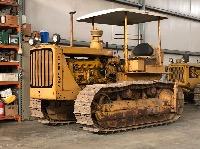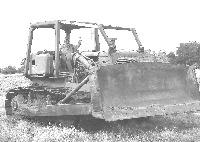- Posts: 4
- Thank you received: 0

ACMOC Membership Benefits
- FREE quarterly magazine filled with content about antique Caterpillar machines
- FREE classified listings
- ACMOC store discounts and specials
- Full Bulletin Board Access
- Marketplace (For Sale/Wanted)
- Technical Library
- Post attachments
$44 /year ELECTRONIC
$60 /year USA
$77 /year International
- Forum
- Antique Caterpillar Machinery Owners Club
- DISCUSSION
- Rusty/corroded o-ring groove seal surface
Rusty/corroded o-ring groove seal surface
- James Lucas
-
 Topic Author
Topic Author
- Offline
- New Boarder
- Member
I'm working on some hydraulic fluid leaks on our old ('65-ish) 922B wheel loader.
Thanks!
Please Log in or Create an account to join the conversation.
- ctsnowfighter
-

- Offline
- Platinum Boarder
- User
- Posts: 1002
- Thank you received: 502
Do attempt to clean as much as you can, even with a hand wire brush, but be very cautious about damaging the surface that mates to the mountng block. These clearances must remain square between the two halves.
1. "O" rings come in various thickness and composition, be sure to use the correct ones.
2. Mating surfaces must have clean and square fit.
3. Tighten evenly.
I operated a SnowBlast Rotary Snow Plow, Hydraulic motor that ran upwards of 4000 psi. Blowing "O" rings was a problem until we figured out the clamping halves were not putting proper pressure on the hose to block, thus not properly compressing the "o" ring. Clearance is critical, especially when running such high pressures and volumes.
Someone else will chime in and offer more suggestions too.
In my opinion, no rubber "o" ring will support high pressures without the proper tight clearances to support it.
CTS
Please Log in or Create an account to join the conversation.
Please Log in or Create an account to join the conversation.
Attachments:
Please Log in or Create an account to join the conversation.
That flange didn't use an O-ring it used a metal back seal.What do you do when you encounter a rusty or corroded o-ring groove sealing surface like the one pictured (attached)? Try to cram sand paper or brillo pad or Scotch Brite into the groove and move it around? Apply a sealant/gasket maker before the o-ring? Try to find a new fitting? Any advice appreciated.
I'm working on some hydraulic fluid leaks on our old ('65-ish) 922B wheel loader.
Thanks!
Since hard back seals aren't available now you need to get a D-ring seal like Cat flange fittings use.
I drought that loader hyds go over 2000 PSI.
That old type hose and fittings are not for very high pressure so inspect then carefully.
Bob
Please Log in or Create an account to join the conversation.
- trainzkid88
-

- Offline
- Platinum Boarder
- Member
- Posts: 2120
- Thank you received: 787
the hose to use sae 100r2 spiral wire hose. if you reuse the older style fittings which have the bolt on hose clamp fit new grade 8 high tensile unf bolts. its also a good idea to replace the bolts that mount the fittings to the machine too.
and yes the seals are a d shape get them from the dealer or a hydraulics service.
to size hose seals and fittings remember they increase by 1 dash size, a dash is equivalent to a 16th of a inch for example 1/2 inch hose and fittings are dash-8 and 3/4 is dash-12
Please Log in or Create an account to join the conversation.
- Forum
- Antique Caterpillar Machinery Owners Club
- DISCUSSION
- Rusty/corroded o-ring groove seal surface
ACMOC
Antique Caterpillar Machinery Owners Club
1115 Madison St NE # 1117
Salem, OR 97301
support@acmoc.org
"I became a member recently because the wealth of knowledge here is priceless."
- Chris R
"I also joined a year ago. had been on here a couple of times as a non-member and found the info very helpful so I got a one year subscription (not very expensive at all) to try it out. I really like all the resources on here so I just got a three year. I think its a very small price for what you can get out of this site."
- Jason N



